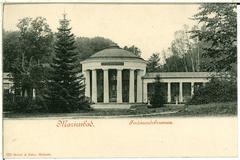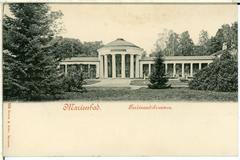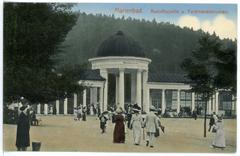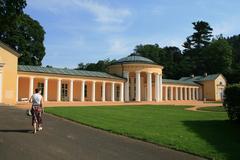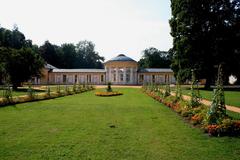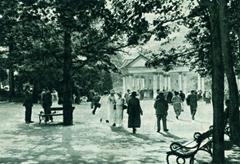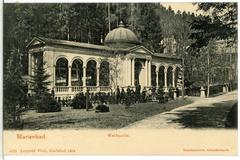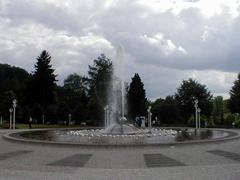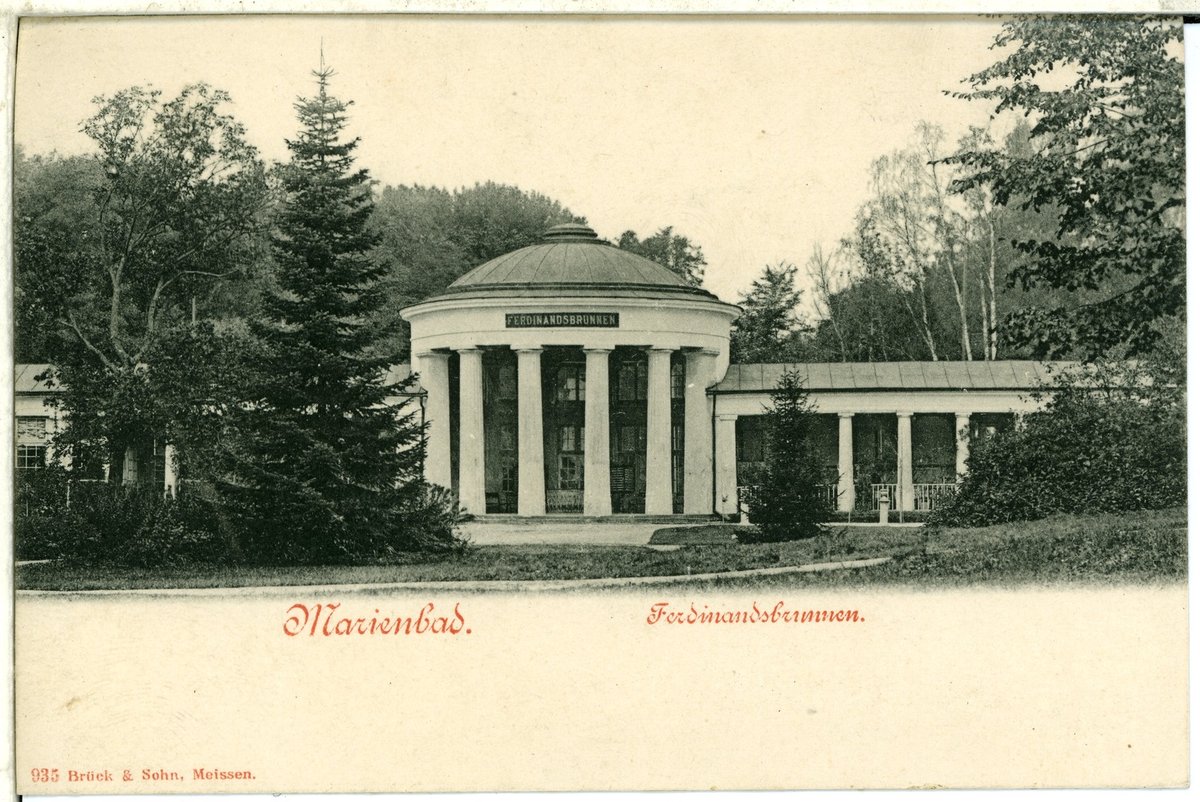
Visiting Guide to Spa Colonnade in Mariánské Lázně, Czech Republic
Date: 24/07/2024
Introduction
The Spa Colonnade in Mariánské Lázně, also known as the Maxim Gorky Colonnade, is an architectural and cultural gem located in the heart of the Czech Republic. Constructed between 1888 and 1889, this neo-Baroque marvel was commissioned by the Abbot of Teplá Monastery and designed by Viennese architects Miksch and Niedzielský, with the cast iron components manufactured at the renowned Blansko Ironworks (boheminium.cz). The Colonnade’s design features a blend of traditional aesthetics and modern engineering, making it a unique and valuable piece of architectural history.
Mariánské Lázně, also known as Marienbad, has a rich history dating back to the 12th century, with its development as a spa town beginning in the early 19th century. The town gained international fame between 1870 and 1914, attracting royalty and notable figures such as King Edward VII of the United Kingdom and composer Richard Wagner (wikipedia.org). The Spa Colonnade, with its intricate ironwork and ceiling frescoes by artist Josef Vyleťal, stands as a testament to this golden era of European spa culture.
This comprehensive guide will provide you with an in-depth look at the Spa Colonnade’s history, architectural highlights, and essential visitor information, including tickets, visiting hours, and travel tips. Discover why this landmark is a must-see attraction in Mariánské Lázně and how it continues to play a central role in the town’s spa culture and heritage.
Table of Contents
- Introduction
- Origins and Construction
- Architectural Significance
- Historical Context
- The Golden Era
- Modernization and Preservation
- Cultural and Therapeutic Importance
- Visitor Information
- Travel Tips and Nearby Attractions
- UNESCO World Heritage Site
- Conclusion
- FAQ
Origins and Construction
The construction of the Spa Colonnade was commissioned by the Abbot of Teplá Monastery and took place between 1888 and 1889. The site chosen for this grand structure was previously occupied by the original spa building known as the ‘Kursal’ (marianskelazne.cz).
The design of the Colonnade was entrusted to Viennese architects Miksch and Niedzielský. The construction was executed by a local builder named Johann Koenig. The cast iron components of the Colonnade were manufactured at the ironworks in Blansko and transported to Mariánské Lázně by train, where they were assembled on-site (boheminium.cz).
Architectural Significance
The Colonnade is an iconic example of neo-Baroque architecture, characterized by its grandiose and elaborate design. The structure measures an impressive 119 meters in length and 12 meters in width. It features a series of ceiling frescoes created by the artist Josef Vyleťal, which depict the theme “The Desire of Man to Fly.” Additionally, the walls are adorned with bronze reliefs by Antonín Kuchař (marianskelazne.cz).
The Colonnade’s design and construction reflect the broader architectural trends of the late 19th century, a period marked by the revival of classical styles and the use of new industrial materials like cast iron. This combination of traditional aesthetics and modern engineering makes the Colonnade a unique and valuable piece of architectural history.
Historical Context
Mariánské Lázně, also known as Marienbad, has a history that dates back to the 12th century when the area was part of the Premonstratensian Abbey at Teplá. The town itself, however, was only established in the early 19th century. The springs in the area were first documented in 1341, but it wasn’t until the efforts of Josef Nehr, the abbey’s physician, that the medicinal properties of the waters were scientifically validated. This led to the development of the spa town, which was officially named Marienbad in 1808 and received its town charter in 1868 (wikipedia.org).
The Golden Era
The period between 1870 and 1914 is often referred to as the Golden Era of Mariánské Lázně. During this time, the town gained international fame as a premier spa destination. It attracted royalty, aristocrats, and notable figures from across Europe, including King Edward VII of the United Kingdom and the composer Richard Wagner. The construction of the railway in 1872 further boosted the town’s accessibility and popularity (greatspatownsofeurope.eu).
Modernization and Preservation
Despite the passage of time and the challenges posed by historical events such as World War II, the Colonnade has been remarkably well-preserved. During the war, there were plans to dismantle the structure for its metal, but fortunately, these plans were never realized. The first major renovation of the Colonnade took place between 1973 and 1981, during which the promenade area between the Cross Spring (Křížový) and Karolina Spring was modernized. The ceiling frescoes by Josef Vyleťal were added during this period (boheminium.cz).
In 2010, the Colonnade was designated as a national cultural monument by the Czech Republic, further cementing its status as a significant historical and cultural landmark (boheminium.cz).
Cultural and Therapeutic Importance
The Colonnade is not just an architectural gem; it also plays a central role in the spa culture of Mariánské Lázně. The town is renowned for its mineral springs, which have been used for therapeutic purposes for centuries. The springs are rich in carbon dioxide and iron, and their waters are believed to cure a variety of ailments, including kidney and urinary tract disorders, respiratory issues, and metabolic conditions (wikipedia.org).
The Colonnade serves as a focal point for visitors who come to “take the cure” in the town’s original spa buildings, which have preserved their historical interiors and equipment. The surrounding park and wooded hills offer therapeutic and recreational trails, enhancing the overall spa experience (greatspatownsofeurope.eu).
Visitor Information
Visiting Hours and Tickets
The Spa Colonnade is open to visitors daily from 7 AM to 7 PM. Tickets can be purchased on-site or in advance through the official Mariánské Lázně tourism website. Prices vary depending on the type of visit, with guided tours available at an additional cost.
Accessibility
The Colonnade is wheelchair accessible, with ramps and elevators available for those with mobility issues. Assistance can be arranged through the visitor center.
Special Events and Guided Tours
Throughout the year, the Colonnade hosts various cultural events, including concerts and art exhibitions. Guided tours are available in multiple languages, offering a deeper insight into the history and architecture of the Colonnade.
Travel Tips and Nearby Attractions
Travel Tips
Mariánské Lázně is easily accessible by train and car. The town offers a range of accommodations, from luxury hotels to budget-friendly options. It’s advisable to book accommodations in advance, especially during peak tourist seasons.
Nearby Attractions
While in Mariánské Lázně, consider visiting other historical sites such as the Singing Fountain, the Church of the Assumption of the Virgin Mary, and the Boheminium Miniature Park. The surrounding natural parks and forests also offer excellent opportunities for hiking and relaxation.
UNESCO World Heritage Site
In 2021, Mariánské Lázně was included in the transnational UNESCO World Heritage Site known as the “Great Spa Towns of Europe.” This designation recognizes the town’s exceptional contribution to the development of European spa culture from the 18th to the 20th centuries. The Colonnade, with its historical and architectural significance, played a crucial role in earning this prestigious recognition (wikipedia.org).
Conclusion
The Spa Colonnade in Mariánské Lázně stands as a symbol of the town’s rich spa heritage and architectural grandeur. Its history, from its construction in the late 19th century to its preservation and modernization efforts, reflects the broader historical and cultural trends of the region. As a focal point of the town’s spa culture and a key element of its UNESCO World Heritage status, the Colonnade continues to attract visitors from around the world, offering a unique blend of historical charm and therapeutic benefits.
FAQ
What are the visiting hours for the Spa Colonnade?
The Spa Colonnade is open daily from 7 AM to 7 PM.
How much do tickets cost?
Ticket prices vary depending on the type of visit. Guided tours are available at an additional cost. Tickets can be purchased on-site or through the official tourism website.
Is the Colonnade wheelchair accessible?
Yes, the Colonnade is wheelchair accessible, with ramps and elevators available.
Are there guided tours available?
Yes, guided tours are available in multiple languages, offering deeper insights into the history and architecture of the Colonnade.
What are some nearby attractions?
Nearby attractions include the Singing Fountain, the Church of the Assumption of the Virgin Mary, and the Boheminium Miniature Park.
Call to Action
Plan your visit to the Spa Colonnade in Mariánské Lázně and experience the blend of history, culture, and therapeutic benefits. For more information and updates, download our mobile app Audiala, and follow us on social media.
References
- Visiting the Spa Colonnade in Mariánské Lázně - History, Tickets, and Travel Tips. Mariánské Lázně. marianskelazne.cz
- Exploring the Spa Colonnade in Mariánské Lázně - History, Visiting Hours & Tips. Museum of Wander. museumofwander.com
- Complete Guide to Visiting Spa Colonnade in Mariánské Lázně - Hours, Tickets, and Tips. Wandering Carol. wanderingcarol.com
- Mariánské Lázně. Wikipedia. wikipedia.org
- UNESCO World Heritage. Arts and Culture. artsandculture.google.com
- Great Spa Towns of Europe. Boheminium. boheminium.cz
